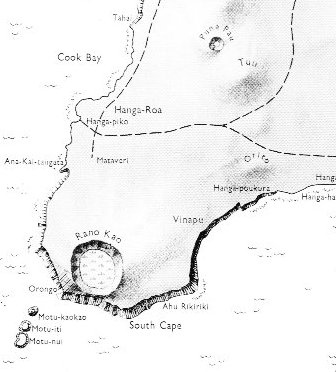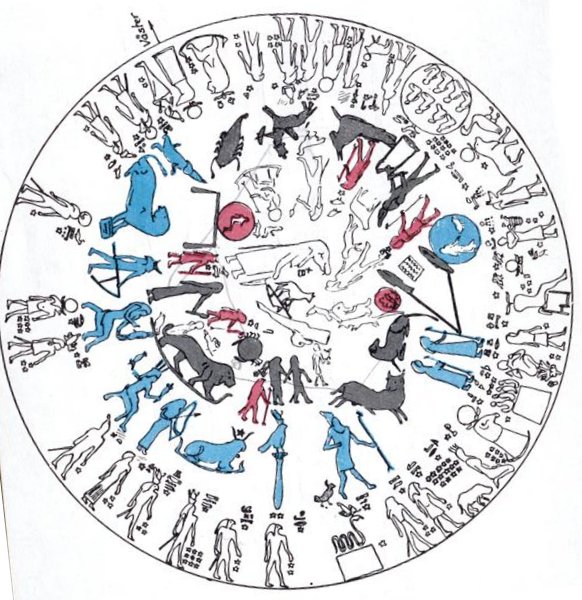6. The sacred geography of Easter Island has an opposition between the northern and the southern coasts, and we are reminded of how on Mangaia the spirits on the northern side of their island entered heaven at one solstice and those on the southern side at the other. Nga Tavake A Rona and Te Ohiro A Te Runu appeared on the scene close to Mataveri: "... the emissaries went from the west coast up to the rim of the crater Rano Kau, where Kuukuu had started a yam plantation some time earlier. After they had departed from Pu Pakakina they reached Vai Marama and met a man. Ira asked, 'How many are you?' He answered, 'There are two of us.' Ira continued asking, 'Where is he (the other)?' To that he answered, 'The one died.' Again Ira asked, 'Who has died?' He replied, 'That was Te Ohiro A Te Runu.' Ira asked anew, 'And who are your?' He answered, 'Nga Tavake A Te Rona.' (E:46) After this, the emissaries and Nga Tavake went to the yam plantation." (Barthel 2) The southwestern corner of the island is where we should look for answers to questions hard to formulate:
Puu Pakakina and Vai Marama are, it is said, close to the northern rim of Rano Kau. There are clues in the following account of the prehistory of the island: "This island was once a great land. The reason it became so small is because Uoke lifted the earth with a (mighty) pole and then let it sink (into the sea). It was because of the very bad people of Te Pito O Te Henua that Uoke lifted the land (and let it crumble) until it became very small. From the uplifted Te Pito O Te Henua, (they) came to the landing site of Nga Tavake, to Te Ohiro. In Rotomea (near Mataveri) they disembarked and climbed up to stay at Vai Marama (a waterplace near Mataveri). During the next month, they moved on to Te Vare (on the slope of the crater Rano Kau). When they saw that the (land-) lifting Uoke also approached (their present) island, Nga Tavake spoke to Te Ohiro: 'The land is sinking into the sea and we are lost!' But Te Ohiro warded off the danger with a magic chant. In Puku Puhipuhi, Uoke's pole broke, and, in this way, at least Nga Tavake's landing site remained (of the formerly great land). (TP:21-22)" (Barthel 2) Lifting up and letting fall down again is an action we recognize from what Ure Honu did when searching for the skull of Hotu Matua (cfr at ua). It probably refers to how the sky roof is being uplifted in spring and then let down again in fall. Furthermore, the same idea recurs in how difficult it was for the explorers to lift the 'turtle' - on the latitude of Easter Island they could not quite succeed in lifting her high. The sky dome with all its stars is shifting to the north in summer north of the equator, but on Easter Island the same stars are shifting to the north in winter. 'Land' being uplifted could refer to the remarkable phenomenon of the sky dome moving up (and down) in a cyclical pattern. The cretor of the round Dendera zodiac found it necessary to show also the signs below those in the normal zodiacal band (the ecliptic) because they had risen so high in summer.
We could recolour this zodiac. Pisces, Aquarius, and the other winter signs, could be bluemarked to indicate they are down in the 'sea' (below the equator of the sky). The rest of the blackmarked (normal zodiacal) signs (those not down in the 'sea') could be marked e.g. red as a sign of being 'uplifted from the sea' (on 'land'). In the center of this zodiacal world there is 'land' (with 'sky' in its very center, close to the pole where the 'world mountain' has its top). This central 'world island' is surrounded by 'sea' all around, not much different from how the conglomeration of the continental land masses down on Earth were found to be surrounded by sea on all sides. If on Easter Island 'land' was sinking into the 'sea' it could mean that the sky dome was not only returning to the view at equinox but that it went on tilting alarmingly further down. Events regarding Mataveri and locations close by could be connected to the entrance to summer. Maybe Rano Kau (where rano is the reverse of rona) is the site of 'birth'. ... The fact that the year ends at Vinapu and begins anew at Anakena may have meaning beyond the obvious transition of time and may also indicate a historic transition. The carbon-14 dating test assigned a much earlier date to Vinapu (ninth century) than to Anakena. This raises the question of an 'original population', which, according to the traditions, lived along the northern rim of Rano Kau (i.e., inland from Vinapu) and their relationship to the explorers ... |

